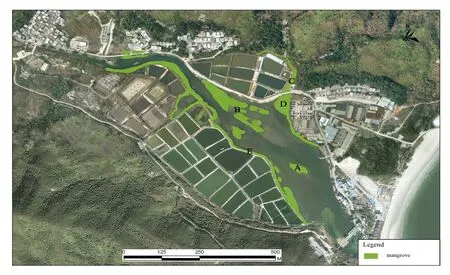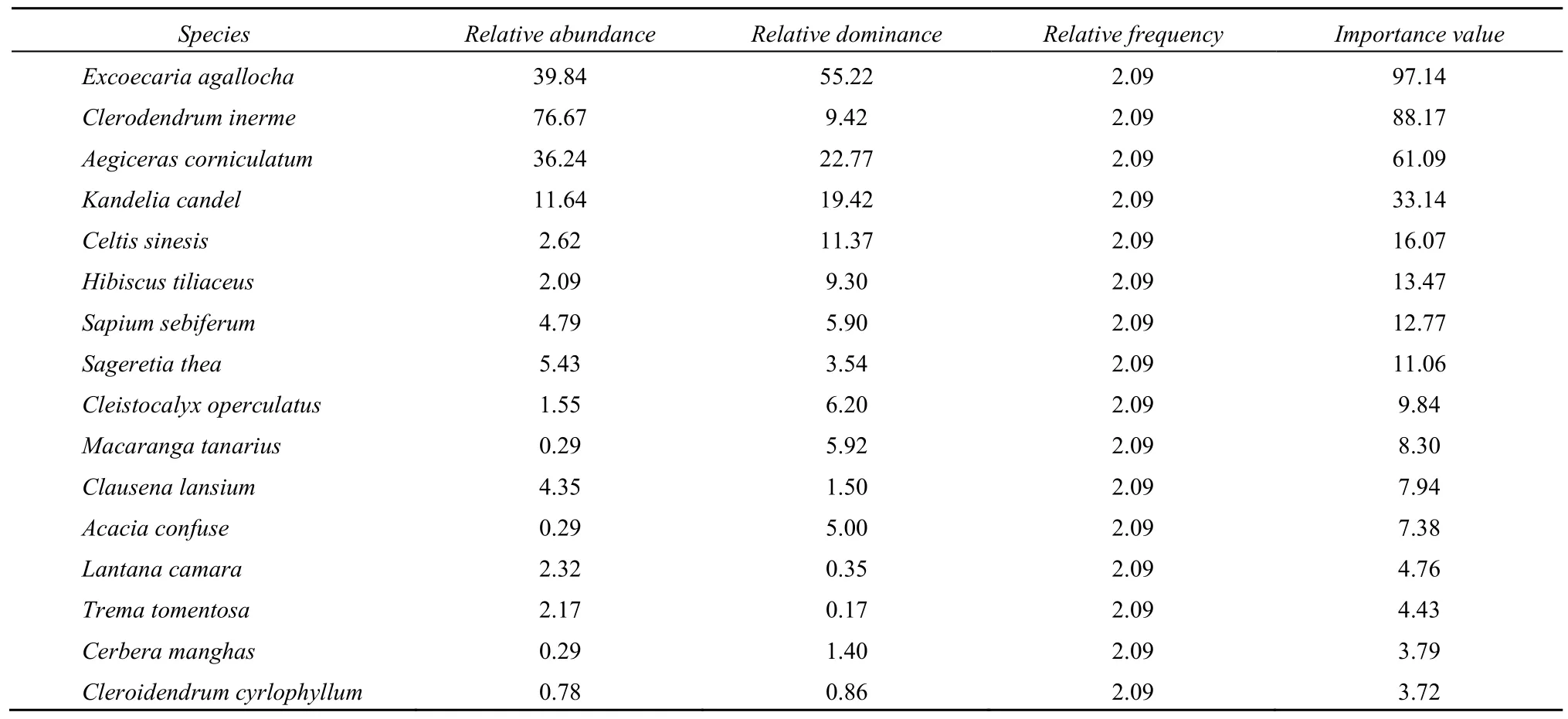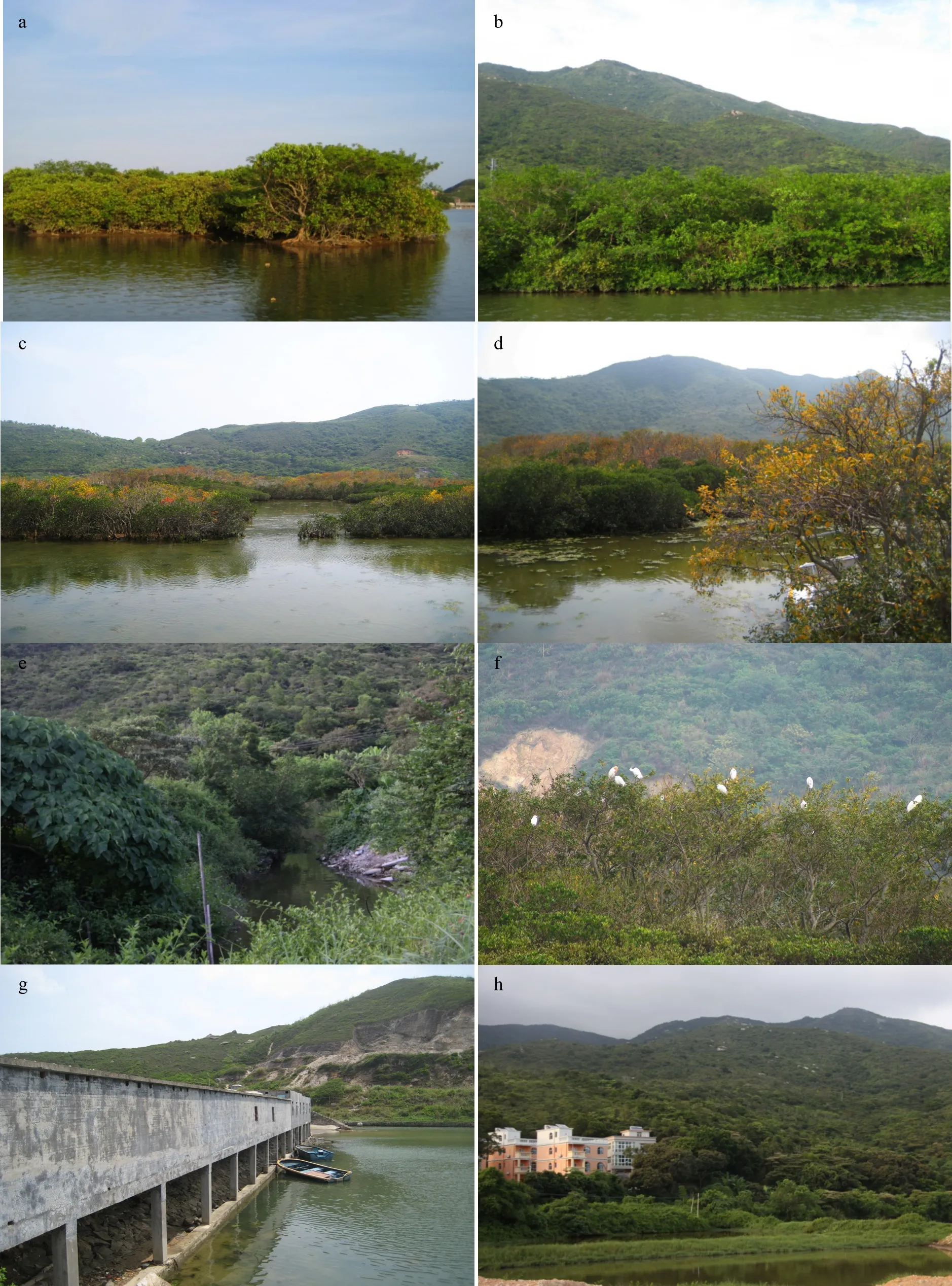A Case Study on the Diversity of the Mangrove Ecosystem in Shenzhen Dongchong, Southern China
2013-10-20YEYouhuaYUBendeGUOWeiLINShishiLIYuexiang
YE Youhua, YU Bende*, GUO Wei, LIN Shishi, LI Yuexiang
1.State Environmental Protection Key Laboratory of Drinking Water Source Management andTechnology /Shenzhen Academy of Environmental Sciences, Shenzhen 518001 China;2.College of Agriculture and Landscape Architecture, Zhongkai University of Agriculture and Engineering, Guangzhou 510225, China;3.Dapeng New District Management Committee, Shenzhen 518120, China
The mangrove ecosystem is complex and diverse,with a special ecological habitat and frame, and is an ecologically critical area of the coastline[1-2].It can provide habitats for plants and animals, decrease the risk of acid sulphate soils, and help buffer against tsunami and cyclones[3-4].As a result of their important ecological functions and services for human beings, a large number of research projects on mangroves have been carried out and documented previously[5-8], and the mangrove has become one of the most important topics in current scientific research.
Shenzhen, one of the cities in the Pearl River estuary, is an extremely important mangrove distribution area in China.Lots of researches on the local mangroves have been carried out for the past two decade[1,8-10].However, most of the studies have been focused on the mangroves of Shenzhen Bay[1-2,11-14],and only a few studies addressed to other areas[13,15].
Actually, in addition to the mangroves ofShenzhen Bay, there exist many mangroves in the east and west of Shenzhen where most of the mangroves were ignored before.Though the area in these areas is relatively small and most of the mangroves are dispersive, the mangroves there are important and can not be ignored for their native property and the Precious value of some species and landscapes.
In the present study, Dongchong mangrove ecosystem which is one of the small mangrove ecosystems in Shenzhen city was investigated.We aimed to study the diversity characteristics of species and landscapes of the mangrove ecosystem and to provide a basis for future Protection and restoration.
1 Methods
1.1 Study area
The study was conducted in Dongchong (E 114°34′34″, N 22°29′40″), which is in the eastern-most part of Shenzhen.Shenzhen, one of the Special Economic Zones in China, is located in the east Pearl River delta area and to the north of Hongkong.Dongchong, covering an area of 24 square kilometers, is backed by Qiniang Mountain to the north and connects with Xichong beach on the west.The 11-kilometer-long coastline of Dongchong embraces Daya Bay on the east and Dapeng Bay on the west.It has a typical subtropical oceanic monsoon climate with an average annual temperature of 22.5 ℃, and an annual average precipitation of 1,966 mm.The total population is 857 and the total GDP is nearly 4 million Yuan per year.
1.2 Data collection and analysis
The remote sensing image of the Dongchong mangrove ecosystem is from Spot 5 of 2008 (Fig.1).In order to study the mangrove ecosystem in Dongchong,field investigation was carried out in the whole area of Dongchong in 2009.In the Dongchong mangrove ecosystem, the main types of mangroves areAegiceras corniculatum-Excoecariaagallocha,Excoecaria agallocha,Clerodendrum inerme-Excoecaria agallocha and Kandelia candel-Aegiceras corniculatum,thus the investigations was carried out based on these types of mangroves. Because theAegiceras corniculatum-Excoecaria agallocha wasdistributed in most of the wetland, two communities of mangrove were investigated.
With respect to the diversity investigation of the mangrove communities, the methods used in the present study were according to Wang et al[16], and the representative sampling quadrat (10 m×10 m)investigation was the major method.The set of sampling quadrat was based on the dominant populations of the trees and the total area of mangroves, and all the sampling quadrats should be on behalf of the plant community situation of the whole wetland ecosystem.The data of the grass communities was basing the random samplings (1 m×1 m).
The species, number, diameter at breast height(DBH, mean±standard error (SE), only for trees),height (mean±SE), mangrove canopy closure and coverage of mangrove were recorded during the process of the tree investigation.The species name was recorded on the spot, and the uncertain species was identified through the specimens according to the Flora of China[17]and the Flora of Guangdong[18].Theheight and canopy closure of the mangrove ecosystem were recorded from estimation based on the lots field ecological investigation experiences.The coverage of the mangroves was based on the projected area of the mangroves.The diameter was investigated using cortex rulers.For the grass layer, we only recorded the names, coverage and highest of the herbage using the same investigation methods as the trees.

Fig.1 Distribution area of the Dongchong mangroves and the measuring sites
In the present study area,Aegiceras corniculatum,Excoecaria agallocha, Clerodendrum inermeandKandelia candelare the dominant species, so we set sampling quadrat based on above species.In the community ofAegiceras corniculatum-Excoecaria agallocha, five quadrats (one in site A and four in site D)were observed.Four quadrats were set in theExcoecaria agallochacommunity and in theClerodendrum inerme-Excoecaria agallochacommunity, respectively.Furthermore, three quadrats were set in theKandelia candel-Aegiceras corniculatucommunity.In a whole,16 representative sampling quadrats were set for the mangrove trees during the study.
Diversity of mangrove community was reflected by richness (Margalef index), diversity (Shannon-Wiener index), evenness (Pielou index) and dominance(Simpson index).According to Wang et al[16]and Zhang et al[19], these four indexes could be expressed as:

Where N is the total number of all plants,Niis the number of theispecies,Piis the ratio of the species’number of theispecies (Ni) in the total numbers of all plants (N), that isPi=Ni/N,i= 1 ,2,3,......S, S is the number of the species.The relative abundance,relative frequency, relative dominance, importance value, diversity index were calculated according to Wang et al[16].The mean value and the standard error of height and DBH were analyzed using SPSS 13.0 (SPSS Inc, USA).
2 Results
2.1 Status of mangrove communities
The mangrove community in the Dongchong area is a type that is typical in China, with a total area of 3 hm2.Evergreen is the main color characteristic,but the area also has 1-2 months yellow or red-yellow period because it contains lots ofExcoecaria agallocha, which is different from other ecosystems in China or even in the world.Because the Dongchong mangrove ecosystem is an infall of inner river and seawater, trees and shrubs are the major ecological types in this ecosystem, and herbs are subordinate under the influence of the tide.The mangroves in the central area of the wetland were protected, while the other mangroves were either destroyed or degraded, to some extent.The canopy of the community is continuous and uniform in most of the area.The average height of the trees shift from 3 m to 6 m, and the highest value of the canopy is 10.5 m.More than 20 species were found in the mangrove ecosystem, of which five were mangrove or semi-mangrove species.Excoecariaagallocha,Clerodendruminerme,Aegiceras corniculatumandKandelia candelwere the dominant mangroves in the Dongchong mangrove ecosystem (Table 1).Low biodiversity was characteristic of this wetland (Table 2), which is a basic feature of the mangrove ecosystem.
2.1.1 Aegiceras corniculatum-Excoecaria agallocha community (Site A)
This community was located in the center of the wetland, the mangroves were well protected, and the coverage was about 95%.This community had a high density of 10 individuals per square meters, which was different from other communities.The upper layer of the community was sparseExcoecaria agallocha, with a mean height of (5.7±0.2) m and a mean DBH of (14.7±1.0) cm.The secondary layer was denseAegiceras corniculatum,with a mean height of (2.5±0.0) m and a mean DBH of (9.2±0.1)cm.There area also had a small number ofKandelia candel.The underlayer was composed ofAcanthus ilicifoliusand the seedlings ofAegiceras corniculatumandKandelia candel.
2.1.2 Excoecaria agallocha community (Site B)
This was the major distribution area of thematureExcoecaria agallochacommunity,with a canopy coverage of 85%.While there were a small number ofAegiceras corniculatum, most of the individuals wereExcoecaria agallocha.The mean height of the trees was (5.3±0.1) m and the mean DBH was (21.9±0.7) cm.The underlayer was composed ofAcanthus ilicifoliusand the seedlings ofExcoecaria agallocha,Aegiceras corniculatumandKandelia candel.Trachelospermum jasminoides, a kind of vine,could also be found in the underlayer.

Table 1 Important value of the species in Dongchong mangrove ecosystem

Table 2 Diversity of mangrove ecosystem in Dongchong
2.1.3 Clerodendrum inerme-Excoecaria agallocha community (Site C)
This community was located at the exit of one streamlet and was isolated by a road.In addition to the mangrove species includingExcoecaria agallocha,Hibiscus tiliaceusandCerbera manghas, some non-mangroves such asSapium sebiferum,Celtis sinesis,Macaranga tanarius,Chaenomeles sinensis,andAcacia confusewere also found in the upper layer.Most of the mangroves wereClerodendrum inermeorAcrostichum aureum,andother mangroves such asAegiceras corniculatumandKandelia candelwere sparse.The height of the upper layer was about(5.3±0.3) m, and the mean DBH was (34.2±5.8) cm.The mean height of theClerodendrum inermewas about (1.8±0.2) m, and the mean DBH was (2.8±0.1)cm.In addition, some liana and grasses, such asIpomoea pescaprae,Pueraria lobata, andApluda mutica, could also be found.
2.1.4 Aegiceras corniculatum-Excoecaria agallocha community (Site D)
In this community, the mangroves were destroyed to some extent by the construction of a road,and the canopy coverage was only about 25%.The upper layer consisted ofAegiceras corniculatum,Excoecaria agallochaand a small number ofKandelia candel,whileClerodendrum inerme,Acanthus ilicifoliusand the seedlings ofAegiceras corniculatumandKandelia candelwere found in the underlayer.The mean height of the trees was about (4.9±0.1) m,and the mean DBH was (22.1±1.2) cm.
2.1.5Aegiceras corniculatum-Kandelia candelcommunity(Site E)
This community was located in the west of the mangrove ecosystem, and the mangroves grew along with the edge of the gei wai.The canopy coverage was ~60%.The species of the upper layer consisted ofHibiscus tiliaceus,Sageretia thea,Excoecaria agallocha,Kandelia candel,Cleistocalyx operculatusandClerodendrum kaichianum,andKandelia candelwas the main species.The shrubs mainly includeAegiceras corniculatumandKandelia candel, and the former comprised more than 75% of the individuals.There were also a small number ofPaederia scandens,Lygodium japonicum and Clerodendrum inermethat were found in the underlayer.The height of the trees and shrubs was (4.1±0.1) m and (2.07±0.0) m, while the BHD of them was (18.47±0.5) cm and (8.48±0.2)cm.
2 Landscape diversity
In the Dongchong area, the landscape types consist of the mangrove landscape (the colorfulExcoecaria agallochalandscape and the evergreen mangrove landscape), the land forest landscape (Lichi chnensislandscape,Casuarina equisetifolialandscape and land shrubs, forest landscape) and the man-made landscape (the gei wai, the dam, and the tidal canal landscape, Fig.2).
The evergreen mangrove landscape is a common characteristic of the mangrove ecosystem, while the colorfulExcoecaria agallochalandscape, the dam and the tidal canal landscape are different from other mangrove ecosystems.There are at least two kinds of migrating birds (Egretta garzettaandArdeola bacchus)that are part of this mangrove ecosystem, thus the migrating bird landscape can be found during the migration time of birds.
3 Discussions
The number of mangrove and semi-mangrove species distributed in the Dongchong area was small and the diversity index was relatively low, which is consistent with other mangrove distribution sites in the world[1,4].In the present study, the field investigation was carried out only in the mangrove ecosystem, not in all the wetlands, including the gei wai and the nearby area, thus the entire number of species was low.In addition, the area of the ecosystem was small, which was another reason for the lower number of species.
Though a relatively small number of species was found in this area, all the mangrove species were native, unlike other mangrove distribution areas in China such as Shenzhen Bay, Maoming, Hainan Island, and Fujian etc.Therefore, this area is one of the most important native reserves for mangroves in China.
The landscape ofExcoecaria agallocha,the dominant mangrove in this ecosystem, is the only reservedExcoecaria agallochalandscape in China.As the typical type of mangroves there,Excoecaria agallochahas important protection and restoration value.Due to the fact that this landscape has a 1-2 month colorful period, this type of mangrove could be planted in other mangrove ecosystems to improve the diversity of the landscape.
Though the Dongchong mangrove ecosystem is remote and the economic level in this area is low, the area of the mangroves has declined almost 30% over the past few decades, and no more than 3hm2of mangroves are left, due to weak protection consciousness, the construction of gei wai (fish pond),roads and buildings.We could only see weed or sparse mangrove plants in the northwest of the wetland,which indicates a degenerating system and is harmful for migrating birds.Rapid urbanization, a low protection and restoration consciousness, and a small budget for environmental improvement were the main factors in the decline of the wetlands.
Because Dongchong mangrove ecosystem belongs to Dapeng peninsula, where the best ecological resources of Shenzhen can be found and the exploitation of coastal resources has recently been proposed, the pressure to protect and restore mangrove ecosystems will continue to increase with the increase in ecological tourism.
According to the property of mangroves in Shenzhen Dongchong, it is necessary to attach much importance to this area and it is time to carry out some measures to protect and restore it.The protection and restoration of the mangrove ecosystem in Dongchong is part of the Shenzhen wetland restoration plan.Even though the protection and restoration planning has been proposed and carried out in Shenzhen city, some wetlands were still in a state of disturbance and decline, and the present study area investigated was one of the cases.

Fig.2 Landscapes of Dongchong mangrove ecosystem
In order to accelerate the development of local economies, to improve residential life, to lessen the damage done to the mangroves, and to increase the area and ecological functions of mangroves, newprotection and restoration district planning is needed.According to Leitão and Ahern[20], landscape ecological concepts and metrics should be applied during the sustainable landscape planning, while the number of research projects on the restoration of wetland has increased in recent years[21-22], and it has become important to protect and restore mangrove ecosystems, hence, restoration projects with landscape ecological philosophy is the key point in present restoration plan for this area.
4 Conclusion
(1)The mangrove ecosystem is small in Shenzhen Dongchong, but it is a very important with native mangrove species and typicalExcoecaria agallochalandscape.
(2)The diversity of the mangrove community is low and the landscapes were diverse even typical in China or even in the world.
(3)District planning is needed and ecological restoration projects with landscape ecological philosophy is the key point for Dongchong mangrove ecosystems.
Reference:
[1]WANG B S, LIAO B W, WANG Y J, et al.Mangrove forest ecosystem and its sustainable development in Shenzhen Bay[M].Science Press,Beijing, 2002.
[2]MAO Z L, YANG X M, ZHAO Z Y, et al.Preliminary study on mangrove ecosystem carbon cycle ofKandelia candelin Futian nature reserve, Shenzhen, China[J].Ecology and Environmental Sciences,2012, 21(7): 1189-1199.
[3]MAO Z L, LAI M D, ZHAO Z Y, et al.Effect of invasion plants(Mikania micranthaH.B.K.) on carbon stock of mangrove ecosystem in Shenzhen Bay[J].Ecology and Environmental Sciences, 2011,20(12): 1813-1818.
[4]TOMLINSON P B.The Botany of Mangroves[M].Cambridge university press, London, 1999.
[5]TUAN L X, YUKIHIRO M, DAO Q T Q, et al.Environmental Management in Mangrove Areas[J].Environ Informatics Archives,2003, 1: 38-52.
[6]MAZDA Y, KOBASHI D, OKADA S.Tidal-Scale Hydrodynamics within Mangrove Swamps[J].Wetlands Ecol Manage, 2005, 13(6):647-655.
[7]DANIELSEN F, SØRENSEN M K, OLWIG M F, et al.The Asian Tsunami: A Protective Role for Coastal Vegetation[J].Science, 2005,310(28): 643.
[8]REN H, WU X, NING T, et al.Wetland changes and mangrove restoration planning in Shenzhen Bay, Southern China[J].Landscape and Ecological Engineering, 2011, 7(2): 241-250.
[9]TAM N F Y, WONG Y S, LAN C Y.Community structure and standing crop biomass of a mangrove forest in Futian Nature Reserve,Shenzhen, China[J].Hydrobiologia, 1995, 295:193-201.
[10]LI T H, ZHAO Z J, HAN P.Detection and analysis of mangrove changes with multi temporal remotely sensed imagery in the Shenzhen River Estuary[F].Journal of Remote Sensing, 2002, 6: 364-369.
[11]CHEN G Z, WANG Y J, HUANG Q L.A study on the biodiversity and protection in Futian National Nature Reserve of mangroves and birds,Shenzhen[J].Chinese Biodiversity, 1997, 5(2): 104-111.
[12]ZHANG H D, CHEN G Z, LIU Z P, et al.Researches on the Shenzhen Futian mangrove wetland ecosystem[M].Guangdong Science and Technology Press, Guangzhou, 1997.
[13]CHEN G Z, PENG S J, WANG Z Y, et al.Researches on the ecological restoration of the Shenzhen western intertidal wetland[C]//The Proceedings of 2002 Annual Conference of China Association for Science and Technology.2002:178-181.
[14]CHEN B Y, SONG Y, ZAN Q J, et al.Dynamics of the Main Landscape Types at Shenzhen Bay during Past Three Decades[J].Acta Scientiarum Naturalium Universitatis Sunyatsent, 2012, 51(5): 86-92.[15]LI H S.The Mangrove of Longgang, Shenzhen[J].Journal of Guangdong Education Institute, 2006, 26(3): 67-69.
[16]WANG B S, YU S X, PENG S L, et al.Experimental notebook of plant community[M].Guangdong Higher Education Press, Guangzhou,1996.
[17]Flora of China.http://flora.huh.harvard.edu/china/
[18]Flora of Guangdong.http://xuebao.scib.ac.cn/gjk/gdzwz/result.asp
[19]ZHANG Y, PENG S, ZHANG Q.Species diversity of Guia Hill Municipal Park in Macao[J].Ecology and Environment, 2008, 17(5):1970-1973.
[20]LEITÃO A B, AHERN J.Applying landscape ecological concepts and metrics in sustainable landscape planning[J].Landscape and Urban Planning, 2002, 59: 65-93.
[21]BISWAS S R, MALLIK A U, CHOUDHURY J K, et al.A unified framework for the restoration of Southeast Asian mangroves-bridging ecology, society and economics.Wetlands Ecology and Management,2009, 17: 365-383.
[22]SOUZA F E S, SILVA C A R.Ecological and economic valuation of the Potengi estuary mangrove wetlands (NE, Brazil) using ancillary spatial data[J].Journal of Coastal Conservation, 2011, 15: 195-206.
